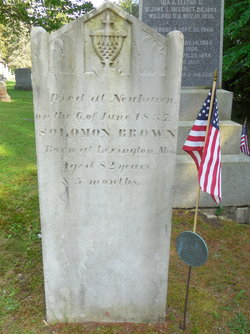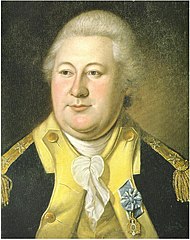Yesterday I described Solomon Brown’s experience on the night of 18-19 Apr 1775: carrying news of British army officers on patrol, being captured by those officers, being released. The deposition that the teenager and two older companions signed a few days later, complaining about how those officers had detained them, leaves the impression that that’s all he did.
Indeed, the depositions that the
Massachusetts Provincial Congress published in April 1775 say little about anyone resisting the
British military in
Lexington on the morning of the 19th. The purpose of those documents was to convince readers that the army had fired without provocation on a peaceful assembly (of armed
militiamen who had been out all night).
I’ve come to approach Revolutionary depositions as usually truthful in what they say, but also prone to significant omissions. In 1775 the folks at Lexington didn’t deny firing back at the redcoats. Rather, when folks were talking with the Patriot magistrates who collected their depositions, the question just didn’t seem to come up.
In 1825 local historian Elias Phinney wanted to make the case that Lexington had been the site of the first forceful resistance against the royal troops—i.e., that the men of his town had fired back, and done at least a little damage. And young Solomon Brown turns out to have been a crucial figure in that aspect of the event as well.
Elijah Sanderson was one of the two men detained along with Solomon for several hours the previous night. Here’s part of his description of the shooting on the green for Phinney:
After our militia had dispersed, I saw them [i.e., the regulars] firing at one man, (Solomon Brown,) who was stationed behind a wall. I saw the wall smoke with the bullets hitting it. I then knew they were firing balls. After the affair was over, he told me he fired into a solid column of them, and then retreated. He was in the cow yard. The wall saved him. He legged it just about the time I went away. In a minute or two after, the British musick struck up, and their troops paraded, and marched right off for Concord.
I went home after my gun,—found it was gone. My brother had it. I returned to the meeting-house, and saw to the dead. I saw blood where the column of the British had stood when Solomon Brown fired at them. This was several rods from where any of our militia stood; and I then supposed, as well as the rest of us, that that was the blood of the British.
Abijah Harrington, one of Lexington’s representatives in the Provincial Congress, added:
A day or two after the 19th, I was telling Solomon Brown of the circumstance of my having seen blood in the road, and where it was. He then stated to me, that he fired in that direction, and the road was then full of regulars, and he thought he must have bit some of them.
A more dramatic description of the teenager’s activity in those minutes was supplied by his son G. W. Brown in 1891. This account was clearly based on decades of local writing as well as family traditions:
Solomon Brown went [from the common] to the right across the Bedford road and jumped over a stone wall. As he landed upon the ground a ball from the enemy passed through his coat, cutting his vest. Another about the same moment struck the wall. He then dropped down behind the wall until their attention was drawn from him.
He then took a circuit in their rear around to the Buckman tavern, where he supposed many of the company had taken refuge, entered the back door, and on going over the house found no one except the pedler [named Allen], who was for a short time prisoner with him on the Concord road the night previous.
He then went to the front door and opened it, when to his surprise the rear portion of the enemy stood in his front, the army having made a halt. No sooner had he stepped in the open door-way than a bullet from an enemy’s gun struck the doorpost about midway. Another following it struck the door near the top.
He then stepped back a little, placed his gun near the muzzle against the door casing, aimed at an officer standing in the ranks of the enemy and fired. Not waiting to see the result he hastened through the house and out at the back door where he entered and made a hasty retreat through the fields.
Being discovered by the enemy, a shower of bullets went whizzing by him until he had reached a distance of some forty rods, when he slipped and fell, and although his clothing bore testimony of the close proximity of some of their bullets, not one marred his person.
And as long as we’re talking about firing from Buckman’s tavern, here’s a detail that militia sergeant
William Munroe gave to Phinney:
The front platoon [of the regulars], consisting of eight or nine, then fired, without killing or wounding any of our men. They immediately gave a second fire, when our company began to retreat, and, as I left the field, I saw a person firing at the British troops from Buckman’s back door, which was near our left, where I was parading the men when I retreated. I was afterward told, of the truth of which I have no doubt, that the same person, after firing from the back door, went to the front door of Buckman’s house, and fired there.
How do we reconcile the details of these accounts? G. W. Brown was probably mistaken about his father having lined up on the green; earlier accounts don’t suggest Solomon was among those men. Instead, the teenager appears to have been all around Buckman’s tavern (shown above, courtesy of the
Lexington Historical Society).
Phinney concluded that Solomon had fired “from a wall” in the front of the tavern, and that a different person had fired from its back door. But the Brown family came to understand that he had been at the back door before going inside to fire from the front. And Munroe understood that one man had fired from both spots—meaning at different times.
Apparently Solomon did something to attract the redcoats’ fire early on—which brings us to the report of Lt.
William Sutherland that the first shot had come “from the Corner of a house to the right of the Church”—i.e., Buckman’s tavern. Another curious detail is Solomon’s surprise at opening the front door of the tavern and finding part of the army massed in front of him. If they had been shooting at him already, even from the green, why was he surprised?
Did regulars shoot at Solomon for a while before he went into the tavern, as he shot from the front door, and then again after he ran out the back? Did the British rear guard shoot at Solomon separate from the first companies on the common? Does that fit with descriptions of how long the firing lasted?
All the accounts from Lexington state that Solomon Brown didn’t fire until
after the regulars had begun the shooting. But of course that’s what they would say. What if Solomon fired the first shot, then ran through the tavern and fired another, and finally “legged it” as bullets flew around him?
If so, it’s easy to understand why. Solomon Brown was eighteen. He’d seen armed officers slipping into his town. He’d been captured at gunpoint and held by those officers for several hours in the middle of the night, deprived of his horse (or his minister’s horse), and left to race back home. For this teenager, the war might already have started.
Then again, the first shot at Lexington could have come from someone whose name has been forgotten, or could have been an accidental discharge that the regulars interpreted as an attack. I’m not convinced Solomon Brown bears any responsibility. But he’s the first guy I’d want to take a deposition from.





